Spoons

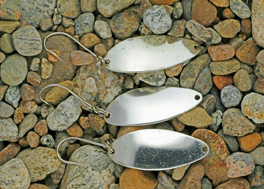
Spoons are effective fishing lures in every season. They also catch any game fish that feed upon bait fish. These lures are good in the shallows or the depths of both lakes and streams. From huge muskies and king salmon down to bluegill, spoons are effective lures. They cast well and are fairly easy to fish. There are some important factors in lure selection and technique that can greatly enhance your success.
The most desired action is not to have the spoon spin around on the retrieve but to have it wobble back and forth without spinning. This slower wobble allows the flash to be spread out effectively. A crippled bait fish wobbles in this same manner-they do not spin over in circles.
There are three important factors in lure selection. They are (1) action, (2) color, and (3) size.
The action is controlled by the speed and nature of the retrieve. When temperatures are ideal for the targeted fish species, the retrieve and action is faster than when the temperature is not ideal. Hence during unfavorable temperature conditions the spoon is fished with a slower retrieve or trolling speed.
The color selection of the spoon is determined by both the light intensity and water color. Perhaps light is the number one condition in your lure color selection. Color is broken down into a rainbow effect. The acronym “roygbiv” describes the placement of each color in the rainbow. (These colors are: red, orange, yellow, green, blue, indigo and violet.) During well-lit conditions, use one of the first three colors: red,

orange or yellow. During low-light conditions, use one of the last three colors. When the water is dark, favor the darker colors of blue, indigo, and violet. Green is a good choice for average lighting conditions. Silver and white are neutral colors that are effective in bright light, low light, clear water, and stained water conditions. Genuine silver is my favorite choice because it produces a hot, white flash in all conditions. But the spoon must have genuine silver plating. Chrome and nickel are seen as a dark, tarnished brown in low light and stained waters. In fact it can turn a black color in the depths.
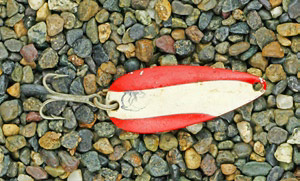
Spoon size should match the size of the forage fish which your targeted fish feed upon. Get to know the bait fish present and their sizes. Early in the season these bait fish are small and are best matched with smaller spoons. But later in the season these bait fish have grown and are best matched with a larger spoon.
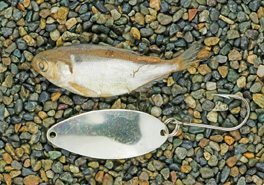
A frustrating event that is easy to fix is when a spoon that is working well early in the morning when the light is low quickly goes dead when the sun rises and causes the light intensity to increase. Now the spoon’s flash is too gaudy and repels fish from striking. Simply downsize the spoon size and you’ll likely be back catching the fish again. The smaller spoon puts off less of a flash and mimics the flash size of the larger spoon in the low light.
The simplest way to fish a spoon is to cast it, count down to the desired depth, and then retrieve it so it wobbles back in. The retrieve is a steady one which is faster in ideal conditions and slowed down in unfavorable conditions. The splash of the cast spoon attracts

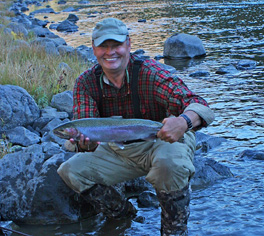
fish and so does its fluttering fall during the countdown.
There are other methods to fish spoons. The spoon can have (1) stop-and-go, (2) tumbling, (3) crawling, and (4) jigging retrieves.
The stop-and-go method allows the spoon to wobble and dart erratically. During the stop, the spoon flutters as it sinks. Simply take in several reel turns and pause. Most strikes occur as the spoon flutters down.
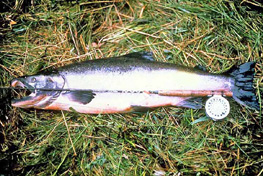
The tumbling retrieve is a variation of the stop-and-go. The rod tip is held high during the reeling portion of the retrieve and the rod tip is dramatically dropped during the stop. This allows the spoon to flutter a greater distance downward. Again, this flutter is when most strikes occur.
Crawling the spoon is done by holding the rod tip high and slowly retrieving the spoon over the top of heavy or thick weed cover. The elevated rod tip pulls the spoon upwards over the structure instead of plowing straight through it. A weed guard and single hook is required.
The jigging retrieve is very effective when you have located the fish and are able to place your position directly over the top of them. Fall and winter are prime times for jigging. I like to target schools of bait fish and jig the spoon underneath them. A crippled minnow will fall underneath the school and struggle to return. All game fish know that this impaired bait fish is an easy catch. Drop the spoon to the bottom on a tight line. Lift the rod upwards about two feet and then lower the rod downwards causing the spoon to flutter back down. Keep this up and down motion throughout the retrieve. Increase the lift to three or four feet as the spoon approaches the top of the water column. Vary the speed and height of the rise and fall. Also try sliding the spoon along the bottom and let it lie there before jigging. Kicking up a puff of mud enhances this method. Keep a sharp eye on the line during the fall and be ready to strike at any unusual line fall. For example, if the lure fails to sink back to the bottom, a
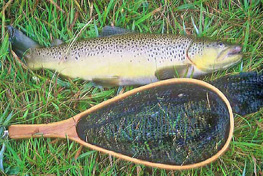
fish has likely sucked it in. Also any line twitching or side movement may indicate a strike. The ideal time to strike is when the fish has closed its mouth. I strike at first indication, but if I come up short I then try waiting until I feel the fish’s pull or weight. Some species, like bass, flare their gills and suck the spoon into their mouth. If I strike too soon, their mouth will not be shut and I will pull the spoon away. So just use common sense as to when to strike, although once the hard steel is detected, the fish can quickly reject the spoon. In cold conditions, my jigging motion is more subdued in both speed and length. I may use an upward motion of only a few inches and will keep a tight line as it sinks. Vertical jigging is effective when you’re right on top of the fish in your boat, pier, or winter ice fishing position. Ideally you want the spoon to be jigged a foot or so above the fish and allow the lure to flutter below them.
Spoons can be fished in a multitude of places in both streams and lakes. In streams I like to cast slightly upstream and across. I start the retrieve once the
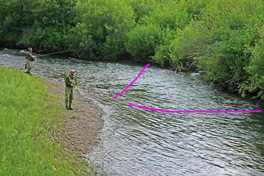
spoon is directly in front of me. I retrieve the spoon towards me with the spoon sideways to the fish. I want the lure to travel about one foot overhead of the fish where the fish can easily see the spoon and can easily attack it. So the lure’s weight plays a vital role in stream fishing. I like it to be heavy enough to sink to one foot above the fish as it drifts to the position directly across stream from me. Next, I want to suspend it there on the retrieve. Again, I do not want it to spin—I want it to wobble. This is what an injured bait fish does as it struggles to swim.
Spoons are effective in the shallows of lakes. A retrieve is varied with the stop- and-go methods allowing the lure to drop down to the fish. Here a lighter spoon is desired.
Brushy lake bottoms hide fish and are excellent places to jig retrieve a spoon. Twitch the rod tip up and down on the retrieve. A hiding fish will come out

from underneath its cover and attack the spoon. Standing timber is another good place to jig a spoon on its retrieve. The submerged branches and base can hide a fish.
Channels carry structure, perhaps better temperatures, and depths to hide fish. The outside curves have the most depth and undercut banks. Plus submerged

brush and tree stumps are common. Fish love to hold in the creek channel edges. Here they can ambush or forage safely along the channel.
Try jigging a spoon anywhere you might find fish.
Sight fishing is best done by casting the spoon off to the side of the fish. Here the retrieve will parallel the fish’s path. Avoid casting to spots between the fish and the sun because the lure’s shadow may spook the fish. Once a fish moves towards the spoon, don’t change your retrieve. Continue what you’re doing. If this doesn’t work, try lifting the rod to speed up the spoon’s escape. Natural preys flee from their predators. Another method is to lower the rod tip so the spoon dives to the bottom to hide.

In clear water, perhaps a tarnished spoon will be more effective. Brass, copper and the like have less of a gaudy flash.

In dingy water, a silver spoon is best because the silver provides a hot, white flash that’s easily seen during conditions of poor visibility.
There are exceptions to all rules. Be prepared to experiment with spoon action, size, and color. Use a heavy spoon to fish deeper water and faster currents. Spoons come in a wide variety of shapes, weights, and colors. It’s impossible for a fisherman to carry all these choices. There are four basic categories: (1) casting spoons, (2) trolling spoons, (3) top water spoons, and (4) jigging spoons.
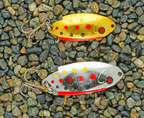
Casting spoons have some thickness and weight to them. They run back and forth on the wobble and have an oval shape with cupped bodies. Thin ones sink slowly and are best for working the shallows. These can be retrieved slowly and are best for cold water. Thick spoons sink faster and are best used to fish fast currents and deep, still water areas. These must be retrieved faster, so they’re better suited for active fish. Attach casting spoons with a split ring and a quality snap swivel. This prevents line twist and gives more wobble action.
Trolling spoons are much thinner and lighter. They are usually too light to cast and are designed to provide a wider wobble at slow speeds. These are fished behind downriggers, diving crank baits, or keel type weights. A typical three-inch trolling spoon weighs only 1/8 ounce.

Top water spoons are weed-less ones with hooks welded in place and protected by a weed guard. The classic Johnson Silver Minnow has been a favorite for years. These spoons can be retrieved over and through thick cover. When the spoons are reeled fast, they rise to the surface and skim over matted cover. Once over a hole, they are given slack line, and they enticingly flutter down inside the hole. Trailers are commonly used. Pork rinds and plastic grubs enhance the lure’s size and the spoon’s wiggle and brings the plastic alive.



Jigging spoons are thick, flat, and heavy. These cast like a bullet. One of my favorites is the Kast Master. They vertically jig well and when retrieved in a stop-and-go manner, they jig as they flutter.
Spoons are effective ways to search out fish in large areas. A heavy casting spoon can cover a lot of water quickly. Fan cast it out, allow it to sink, and retrieve it back in.
Once you have covered lots of water you will have located where the fish are holding. Then concentrate on more precise methods such as jigging, stop-and-go, and fluttering.

In both lake and stream fishing, I want my spoon to be fished about one foot overhead of the fish so the fish can easily see it and catch it.
When trolling behind a downrigger, place a thinbladed spoon five to fifteen feet behind the cannonball.
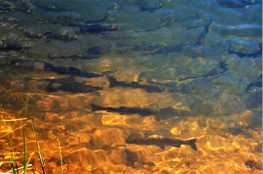
Attach a split ring and swivel to the lure. This frees it up so it can wobble freely at the slowest speeds.
A light trolling spoon on a long line behind the boat is an effective way to fish for surface foraging fish. The use of an outrigger places the spoon to the side of the boat. It works when fish are spooky and flare away from the path of the boat.
Don’t forget trolling a spoon directly in back of the outboard. Many times the turbulence of the churning propeller may attract fish to investigate.
One of my favorites is crank bait used to dive the light-weight spoon down to the fish. The line should be on the long side. The wiggle of the crank bait enhances the wobble of the spinner. Rig with a three-way swivel and be prepared to catch fish on the crank bait.
Experiment with retrieve speed and action. Change spoon size and color until you discover what works best.
I’ve fished trailers behind spoons for years. A casting, wobbling spoon with a small, dark fly towed behind has been a producer in alpine lakes.
One of the hottest bluegill fishing methods is to fish a micro spoon with a trailing plastic grub on the back of one of the treble hooks. Perhaps this is one of my favorite bluegill methods. Also, trailing, plastic swim bait on a heavy casting spoon has taken many a huge king salmon. That’s what I like about spoons. They work on any species.
My favorite spoons are the traditional Daredevil, the Krockodile, the Williams Wobblers, the BC Steal, the Steelie, the Pixie Spoon, the Little Cleos, Johnson minnows, the Hopkins, and the Triple Teaser. This is only a partial list.
The BC steal is one of my favorites because it comes in genuine silver or even real gold


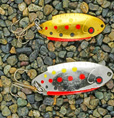

plate. But what I like best is

that it comes in three thicknesses in the same sized spoon. This gives you chances to fish shallow, mid depths, and depths. Its size and shape mimic sardines. I like to use it for salmon and steelhead.
Spoons are easy to trick up. Permanent marking pens in an assortment of fluorescent colors can customize a silver spoon quickly. Mylar tape

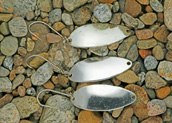
patterns are easy to cut and stick on.
In conclusion, spoons are an overlooked and under used lure. Their greatest popularity was back in the 1950’s, but they are incredibly effective today for lakes, streams, and all species that eat bait fish. They are easy to fish and a go-to for finding fish.

© 2025 The Gale Group, Inc. All rights reserved.
© 2025 Perigee Learning LLC. All rights reserved.
LoveTheOutdoors.com is owned and operated by Advameg, Inc. © 2025 Advameg, Inc.
Camping Adventures • Dutch Oven Cooking • Sports Knots
Fly Tying • Freshwater Fishing • Fly Fishing

